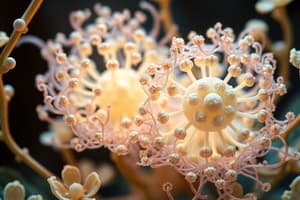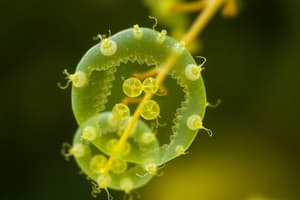Podcast
Questions and Answers
What is the primary mode of nutrition in Chlamydomonas?
What is the primary mode of nutrition in Chlamydomonas?
- Heterotrophic, using organic compounds as a source of energy
- Symbiotic, depending on other organisms for energy
- Autotrophic, using photosynthesis to produce energy (correct)
- Mixotrophic, using both autotrophic and heterotrophic modes
What is the composition of the cell wall in Chlamydomonas?
What is the composition of the cell wall in Chlamydomonas?
- Chitin and glycoproteins
- Peptidoglycan and lipopolysaccharides
- Cellulose and chitin
- Cellulose and glycoproteins (correct)
What is the purpose of the eye-spot in Chlamydomonas?
What is the purpose of the eye-spot in Chlamydomonas?
- To respond to touch stimuli
- To regulate cell division
- To navigate towards light sources (correct)
- To sense changes in temperature
What is the mode of asexual reproduction in Chlamydomonas?
What is the mode of asexual reproduction in Chlamydomonas?
Why is Chlamydomonas used as a model organism in scientific research?
Why is Chlamydomonas used as a model organism in scientific research?
What is one of the applications of Chlamydomonas in biotechnology?
What is one of the applications of Chlamydomonas in biotechnology?
What is the type of motility exhibited by Chlamydomonas?
What is the type of motility exhibited by Chlamydomonas?
What is the purpose of Chlamydomonas in agriculture?
What is the purpose of Chlamydomonas in agriculture?
Flashcards are hidden until you start studying
Study Notes
Chlamydomonas: A Model Organism
What is Chlamydomonas?
- A genus of green algae, consisting of about 600 species
- Unicellular, eukaryotic organisms
- Found in freshwater environments, such as ponds, lakes, and rivers
Characteristics
- Cell structure:
- Flagellated, allowing for motility
- Cell wall composed of cellulose and glycoproteins
- Single chloroplast for photosynthesis
- Metabolism:
- Autotrophic, using photosynthesis to produce energy
- Can also use acetate as a carbon source
- Reproduction:
- Asexual reproduction by simple cell division
- Sexual reproduction through isogamy (fusion of identical gametes)
Importance in Scientific Research
- Model organism: Chlamydomonas is widely used in scientific research due to its:
- Simple cellular structure
- Ease of cultivation
- Genetic tractability
- Studying:
- Photosynthesis and chloroplast biology
- Cilia and flagella function
- Cell signaling and behavior
- Evolutionary biology
Applications
- Biotechnology: Chlamydomonas is used in:
- Production of biofuels and bioproducts
- Wastewater treatment and bioremediation
- Development of novel therapeutics
- Agriculture: Chlamydomonas is used as a:
- Biofertilizer to enhance crop growth
- Bioprocessor to remove pollutants from soil
Interesting Facts
- Eye-spot: Chlamydomonas has a light-sensitive organelle called the "eye-spot" that helps it navigate towards light sources
- Genetic diversity: Chlamydomonas has a high degree of genetic variation, making it an ideal model for studying evolutionary processes
Chlamydomonas: A Model Organism
Characteristics
- Chlamydomonas is a unicellular, eukaryotic organism with a flagellated structure, allowing for motility
- Cell wall consists of cellulose and glycoproteins
- Single chloroplast is responsible for photosynthesis
- Autotrophic metabolism, using photosynthesis to produce energy
- Can also use acetate as a carbon source
- Asexual reproduction occurs through simple cell division
- Sexual reproduction occurs through isogamy (fusion of identical gametes)
Importance in Scientific Research
- Chlamydomonas is a widely used model organism due to its simple cellular structure, ease of cultivation, and genetic tractability
- Ideal for studying photosynthesis and chloroplast biology
- Used to investigate cilia and flagella function
- Studied for cell signaling and behavior
- Important in evolutionary biology research
Applications
- Used in biotechnology for production of biofuels and bioproducts
- Employed in wastewater treatment and bioremediation
- Utilized in development of novel therapeutics
- Used as a biofertilizer to enhance crop growth
- Used as a bioprocessor to remove pollutants from soil
Interesting Facts
- Possesses a light-sensitive organelle called the "eye-spot" that helps it navigate towards light sources
- Exhibits a high degree of genetic variation, making it an ideal model for studying evolutionary processes
Studying That Suits You
Use AI to generate personalized quizzes and flashcards to suit your learning preferences.




